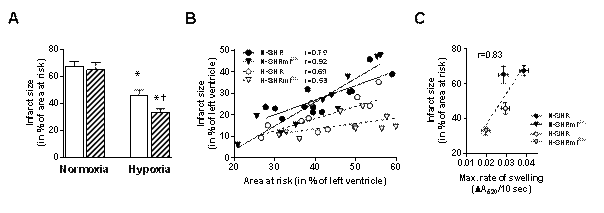|
|
|
Close Help | ||||||||||||||
Ischemic heart disease is the leading cause of morbidity and mortality in the Western world.
Development of new procedures decreasing myocardial injury as a result of myocardial infarction has therefore important clinical implications. Previous studies performed at the Institute Physiology CAS showed that adaptation to chronic hypoxia is one of the long-lasting cardioprotective strategies.
Mitochondria are one of the main sources and targets of damage during myocardial infarction and play an essential role in improved cardiac ischemic tolerance conferred by adaptation to chronic hypoxia. Here, we analyzed the effects of chronic hypoxia on mitochondrial functions, including the sensitivity of the mitochondrial permeability transition pore (MPTP) to opening, and infarct size in hearts of spontaneously hypertensive rats (SHR) and the conplastic SHR-mtBN strain, characterized by the selective replacement of the mitochondrial genome of SHR with that of the more ischemia-resistant Brown Norway (BN) strain. Chronic hypoxia decreased myocardial infarction in SHR. In hypoxic SHR-mtBN strain, infarct size was significantly smaller compared with hypoxic SHR. Mitochondria isolated from hypoxic hearts of both strains had increased detergent-stimulated cytochrom c oxidase activity and were less sensitive to MPTP opening. The maximum swelling rate was significantly lower in hypoxic SHR-mtBN strain compared with hypoxic SHR, and positively correlated with myocardial infarction in all experimental groups. Therefore, the mitochondrial genome of SHR modulates the infarct size-limiting effect of adaptation to chronic hypoxia by affecting mitochondrial energetics and MPTP sensitivity to opening.

Myocardial infarct size expressed as a percentage of the area at risk (A), relationship between area at risk and infarct size (B) and relationship between the maximum rate of mitochondrial swelling and infarct size (C) in SHR (white column) and SHR-mtBN (hatched column) adapted to continuous normobaric hypoxia and normoxic controls.
Neckář, Jan - Svatoňová, Anna - Weissová, Romana - Drahota, Zdeněk - Zajíčková, Pavlína - Brabcová, I. - Kolář, D. - Alánová, Petra - Vašinová, Jana - Šilhavý, Jan - Hlaváčková, Markéta - Tauchmannová, Kateřina - Milerová, Marie - Ošťádal, Bohuslav - Červenka, L. - Žurmanová, Jitka - Kalous, M. - Nováková, Olga - Novotný, J. - Pravenec, Michal - Kolář, František. Selective replacement of mitochondrial DNA increases the cardioprotective effect of chronic continuous hypoxia in spontaneously hypertensive rats. Clinical science. Roč. 131, č. 9 (2017), s. 865-881 ISSN 0143-5221. IF: 4.936/5.315